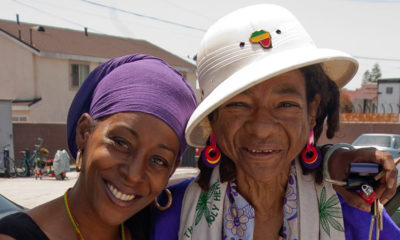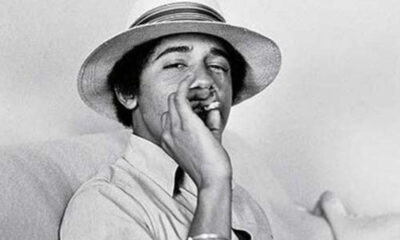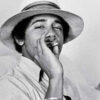
In History
The Story of Sgt. Will: How Cannabis Helped Save a Veteran’s Life
There is no cure for and cannabis is one of the few safe legal options to treat the life-threatening symptoms of PTSD.
“In the army we laughed at the prospect of going to war in 2000,” said William Calhoun.
But Calhoun did go to war — three times. As a sergeant in the 1st Battalion 5th Special Forces Signal Detachment in the U.S. Army, he served a tour of duty in Afghanistan during the initial invasion in 2001 and two subsequent tours in Iraq as part of Operation Iraqi Freedom.
Similar to at least 20 percent of veterans returning from service in Iraq and Afghanistan, Calhoun suffers from post-traumatic stress disorder (PTSD). And, like 22 veterans every day, Calhoun attempted to take his own life — twice — except he lived. Now, he has uprooted his life and moved to the Pacific Northwest to legally use cannabis to treat his symptoms and is looking to participate in the first FDA-approved study on how cannabis works to treat the symptoms of PTSD.
“Twenty-two veterans are going to die today at their own hand. I was one of them,” Calhoun said.
The Decision to Enlist
Calhoun made the decision to enlist in 1999, when he was just 16 years old. He didn’t even know he would be paid beyond room and board. At the time he was a high school senior; he was smart, a gifted athlete, artist and sponsored skateboarder with the desire and ability to go to college, but no means.
“I decided to enlist because I was sick of my home life, on top of the fact that I was well qualified to go to college — I was smart enough, ambitious enough — but had no money at home,” he said. “I didn’t even fill out the college paperwork, my home life was such that that wasn’t even a thing.”
Calhoun grew up the child of a single mother with two siblings in Los Angeles. They often lived with their grandfather when their mother was unable to take care of them. Their grandfather had been in the Air Force and traveled extensively throughout the Middle East. The home was decorated in relics from the trips, and growing up Calhoun enjoyed hearing stories of his grandfather’s travels through Egypt and held a particular fascination with the pyramids.
Calhoun had a desire to travel and knew he could earn a college degree in the army. In the late ’90s, the concept of a decade-long war was laughable; it seemed like a responsible plan. Little did he know, the nation was about to wage its longest war and his biggest struggle was just beginning.
September 11, 2001
“I was Sergeant Calhoun, not skateboarder William,” he said. “My life in the army was quite a bit different than the average 17-year-old.”
Calhoun scored high on military placement tests, his technical skills making him valuable. He was interacting with senior officers and learning to manage military Internet connections.
On Monday, Sept. 10, 2001, Calhoun was participating in a training operation near Fort Campbell, Tennessee. He had gone through basic training and had a scheduled deployment to Egypt in October; he was excited to see the pyramids like his grandfather had.
The training operation was a simulation of a terror attack by a Middle Eastern terror cell. Calhoun’s unit was playing the enemy.
On Tuesday, the mission was brought to an abrupt halt. At first, he and the rest of the soldiers didn’t believe the country was under attack — they had been cut off from all outside contact during the training and the news was too similar to the fiction they were enacting. But, this attack was real.
At 8:26 a.m. EDT, American Airlines Flight 11 en route from Boston to Los Angeles was hijacked and crashed into the north tower of the World Trade Center in lower Manhattan. Thirty minutes later United Airlines Flight 175 crashed into the south tower. Both towers collapsed, killing thousands of civilians and the policeman, firefighters and rescue crews attempting to save them.
Two more planes were hijacked and crashed before 10 a.m.; American Airlines Flight 77 from Washington, D.C. was crashed into the Pentagon at 9:37 a.m. A final hijacked plane, United Airlines Flight 93 en route from Newark, New Jersey to San Francisco, was downed in a field near Shanksville, Pennsylvania, after a struggle between hijackers and passengers. In total, nearly 3,000 Americans, mostly civilians, were killed on American soil.
Responsibility for the attacks was placed on al-Qaeda, specifically founder and leader Osama bin Laden, who initially denied involvement, but later claimed responsibility.
In October 2001, Calhoun was deployed to Egypt, where he got to visit the pyramids. By November, he was in Bagrom, Afghanistan participating in the initial invasion, Operation Enduring Freedom.
The U.S. invaded Afghanistan to depose the Taliban, the strict Islamic governing body of the region, who were suspected of harboring al-Qaeda and Osama bin Laden. After the initial invasion, Calhoun’s unit was assigned to the nation’s capital, Kabul, to gather intelligence to find bin Laden.
During his time in Kabul, Calhoun spent most of his time in the basement of a safe house in civilian clothing managing satellite Internet connections. His unit lived with two embedded CNN reporters. When he wasn’t busy with military work, he played video games for hours.
Calhoun participated in Operation Anaconda, a large-scale, unsuccessful effort to extract bin Laden and other al-Qaeda officials and infantry from the mountains southeast of Kabul on the Pakistani border. The story of his unit was detailed in the book “The Hunt for bin Laden: Task Force Dagger” by Robin Moore.
“Operation Anaconda should have been the end of it,” Calhoun said.
The ensuing manhunt for bin Laden would go on for the next 10 years. In May 2011, bin Laden was captured and killed by U.S. Navy SEALs at a safe house in Abbottabad, Pakistan. Later, Calhoun would learn that one of the CNN reporters he had been embedded with in Kabul had been captured and executed.
“A Good Fight”
After a tour in Afghanistan, Calhoun returned to Fort Knox for six months. He was then deployed to Baghdad, Iraq.
On March 20, 2003, the United States and coalition forces invaded Iraq in a dramatic bombing campaign of Baghdad, dubbed “Operation Shock and Awe,” which was broadcast on live television around the world.
The premise for a war in Iraq was that the George W. Bush Administration claimed they had intelligence proving Iraqi dictator Saddam Hussein had obtained and was willing to use weapons of mass destruction. Hussein was also accused of harboring targeted members of al-Qaeda, who the United States was still fighting in nearby Afghanistan.
Calhoun would go on to do a total of two tours of Iraq between 2003 and 2005. In Iraq he saw heavy combat. No weapons of mass destruction were found.
Years had passed since the terrorist attacks on September 11 and more information had been spreading online since the U.S. had launched its second war in the Middle East. Calhoun managed satellite Internet connections and was able to not just play Tony Hawk Pro Skater, but also read the news and information surfacing online about the conflict.
“In Afghanistan I thought I was some sort of weird crusader on a righteous mission. I was brainwashed to believe we were fighting a good fight, they [the military] can feed your ego,” he said. “The truth is you’re just a hot-headed baby with a gun.”
After his final tour in Iraq, Calhoun returned home in 2005 hoping to earn a college degree.
Death and Dreams
“I decided to get out and go to college — because that’s why I joined,” he said. “I had big plans for my life, I wanted to be a humanitarian, somebody that helps more people and I had the capacity to. I wanted to go to medical school and do big things, but when I came home I couldn’t even sleep without having dreams about killing children or seeing children get killed.”
Calhoun recalls an 11-year-old boy he met in Iraq who he and other soldiers had nicknamed “Z” because they couldn’t pronounce his name. Z’s parents had been killed and his entire village leveled during an American military operation. The unit informally adopted Z and Calhoun was tasked with watching him. Calhoun taught him about skateboarding, video games and a little bit of English. He has not seen or heard from Z since he left Iraq 10 years ago.
“I deal with things like that, where is this kid now?” Calhoun said. “I get out of the army and I can’t function in society, can’t eat or sleep.”
Multiple soldiers in Calhoun’s unit are dead – most at their own hands after returning home from war.
“My dreams keep me awake at night because I have dreams of hurting people,” Calhoun says. “You take the destructive part — seeing dead bodies, burned villages, upside down cars — and you combine that with the dream form, self medication, drug use and environmental influences like South Central Los Angeles — now you’ve got what goes on inside my head when I sleep.”
As the insomnia worsened, so did his other symptoms. He was easily agitated and was fired from his job. His family grew concerned and he went with is mother to the Veterans Affairs (VA) hospital to see a doctor. In a one-hour consultation, he was diagnosed with PTSD and prescribed Buspirone for anxiety in addition to Trazadone, Remeron (Mirtazapine) and Bupropion (Welbutrin) — all for depression.
Side effects of Buspirone include insomnia and suicidal thoughts. Side effects of Trazadone include suicidal thoughts, a side effect so serious the medication now comes with a black box warning from the FDA. Mirtazapine can cause insomnia and abnormal dreams. Wellbutrin can cause depression and suicidal thoughts.
“At this point my entire life — well, a lot of it — had become a waking state of a video game. The shitty part is you get high on those drugs. You get a buzz on them. Two of those pills can be crushed and sniffed [Buspirone and Wellbutrin], two are sought out in jails. They are addictive,” he said.
Calhoun’s younger brother had enlisted after 9/11 and was also a combat veteran. They both became addicted to the legal drugs they were prescribed and shared pills. Calhoun also used illegal drugs, like heroin. He had trouble holding down jobs and was in and out of jail for getting into fights.
“They give you drugs and money and tell you to go away,” he says. “Life for me, for those years, was real fucking weird. I was just masking it all with a pill that was turning me into this brain candy robot.”
Calhoun’s insomnia got so severe he didn’t sleep from February through May of 2010, which culminated in his first suicide attempt. He swallowed 62 Xanax and a “handful of Oxycontin” and went into a coma for three days. His doctors continued to prescribe him more psychotropic drugs for depression and anxiety.
“I tried, trust me I tried [to live]. Heroin didn’t work, Trazadone, Seroquil — nothing worked because your mind is more powerful than anything.”
After two unsuccessful suicide attempts (both using high volumes of pharmaceutical drugs), Calhoun began practicing Buddhism, stopped taking the pharmaceuticals and began primarily using cannabis to cope with the symptoms of his PTSD. He has not tried to take his own life again. He and his girlfriend, Ashley, left their lives on the East Coast and moved west to pursue legal, medical cannabis to manage Calhoun’s PTSD.
Calhoun has become involved with veterans activist groups such as 22 Too Many and is now looking at participating in the first FDA-approved study on cannabis and PTSD conducted by Dr. Sue Sisely.
From Black Boxes to Red Tape: The Bureaucratic Nightmare of Studying Cannabis for PTSD
A handful of studies on cannabis and PTSD have been done. However, they look primarily at the incidences of “cannabis drug abuse” which are positively correlated with diagnoses of PTSD. Multiple studies have shown that those suffering from insomnia, depression or PTSD have higher incidences of cannabis abuse, but these studies equate any use with abuse.
There is no cure for and there are few safe legal options to treat the life-threatening symptoms of PTSD. Cannabis is non-toxic and will not kill a patient, nor will it cause suicidal thoughts.
“The marijuana has helped him so much more than taking [pharmaceutical drugs],” said Ashley Drew, Calhoun’s girlfriend.
Drew uprooted her life in her home of upstate New York to support Calhoun in moving west to use medical cannabis instead.
“[Pharmaceutical drugs] wouldn’t take the pain away. When he smokes, he levels out and is happy – there is no withdrawal. If he is on Percoset or any other drug like that, he isn’t really living because he is manic,” Drew said.
In August, Drew and Calhoun met Dr. Sue Sisely at Seattle Hempfest and are currently in discussions to participate in Dr. Sisely’s groundbreaking study on cannabis and PTSD.
Sisely is a researcher and psychiatrist formerly with the University of Arizona (UA) who was granted approval from Food and Drug Administration (FDA) to study cannabis as a treatment for PTSD, specifically in combat veterans. In March 2014, the study was approved by the U.S. Department of Health and Human Services, in July 2014 she was terminated from UA.
Sisely’s study is being independently funded by the Multidisciplinary Association for Psychedelic Studies (MAPS). Planning for the study began 10 years ago and it has been FDA-approved for four years, but Sisely’s study has still not begun.
“You have vets drowning in pills and I am part of that, I am part of that problem,” Dr. Sisely said addressing the audience at the Marijuana for Medical Professionals Conference on Sept. 11, 2014 in Denver. “I have put so many veterans through the gauntlet of every FDA-approved medicine on the market and in the end what they finally disclosed to me over the last many years is that they have been finding ways to use marijuana successfully to manage their PTSD. I just could not ignore that anymore. I tried to dismiss it and I realized we had a duty to these veterans to study this plant rigorously and understand what it is.”
Beyond the bureaucratic red tape that prevents studies on the potential positive medical effects of cannabis, most veterans don’t have access or the ability to use cannabis to treat their symptoms.
In Colorado, where cannabis is legalized for both medical and adult use (over 21), veterans have been embroiled with the state to have PTSD added to the list of qualifying conditions for medical cannabis. In July, the Colorado Board of Health voted 6-2 against adding PTSD to the list of qualifying conditions citing a lack of FDA-approved studies supporting its use.
Veterans purchasing cannabis in a “recreational” dispensary are subject to higher base prices for their medicines and a 20 percent or higher sales tax in addition to having lower legal limits for possession.
“We’ve legalized it. We’ll take the tax dollars from our tourists for recreational marijuana before we’ll help our vets,” John Evans of Vets 4 Freedoms told the Denver Post.
Five patients with PTSD, four combat veterans and one sexual abuse survivor, are now suing Colorado to have the condition added. If Colorado added the condition, it would only be the 10th of 23 states to do so.
Studies have shown the potential of cannabinoids to induce fear extinction, or allow sufferers of PTSD to stop feeling the emotions with and replaying traumatic incidences in their mind. Sisely’s study would be the first to look at whole-plant cannabis smoked and vaporized by humans — specifically combat veterans.
“Marijuana researchers have to have the stamina to overcome all these hurdles but we can help them as citizens. We can work to change public policy to help end these ridiculous unnecessary barriers to conduct this work,” Sisely said.
Today William Calhoun is living between southern Washington and the Portland, Oregon, area. PTSD is a qualifying condition for medical marijuana in both Washington and Oregon, states that also have legalized cannabis for adult use. He is working in art and design in the cannabis industry and taking his PTSD one day at a time.
“I’m as deserving to take my medicine as you are,” he said.
Do you support veterans’ rights to cannabis? Tell us below.

























